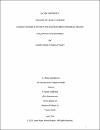Cardiac Rehabilitation in the Eastern Mediterranean Region: Utilization and Barriers Supervisor ofThesis: Karam Turk-Adawi, Mohammed Fasihul Alam
| Advisor | Turk-Adawi, Karam |
| Advisor | Alam, Mohammed Fasihul |
| Author | Afaneh, Jasser Abed Ahmed |
| Available date | 2018-12-13T06:28:49Z |
| Publication Date | 2018 |
| Abstract | Background: Cardiovascular diseases (CVDs) are the leading cause of death and disability in the Eastern Mediterranean Region (EMR). In the next decade, CVDs are estimated to increase in the EMR more dramatically than any other World Health Organization-designated region, except Africa. Cardiac rehabilitation (CR) is a comprehensive secondary prevention program that designed to recover a cardiovascular event. Purpose: The purpose of this study is to investigate characteristics, availability, utilization, and barriers to CR programs in the EMR. Methods: This is an observational, cross-sectional study, based on a secondary dataset driven from a global study conducted by the International Council of Cardiovascular Disease Prevention and Rehabilitation. Statistical analysis methods: Descriptive statistics: frequencies, percentages, means, standard deviations, and medians were used to describe findings. Results: Of the 22 countries in EMR, only 12 (54.5%) countries offered CR; 49 programs were identified but only 24 participated (response rate=49.0%). All identified CR programs were located in urban areas. CR density in EMR, ranged from 184,744 patients with ischemic heart disease per program in Egypt to 3,842 patients per program in Bahrain. Only 8 (38.1%) respondents reported that patients were referred regularly to their CR program. The duration of CR programs varied from 5 weeks in Tunisia to 20 weeks in Lebanon with an average of 9.4±5.4 weeks in EMR. Only 5 (20.8 %) programs were publicly funded while 8 (33.3%) were privately funded. CR programs were underutilized with a range of ratio of capacity served to actually serve per year of 1.2:1 to 8.0:1 in Qatar and Egypt, respectively. Lack of patient referral, lack of financial and human resources were perceived as the most barriers to CR. Conclusion: In EMR, CR programs were insufficiently implemented for a population with a high and growing burden of cardiovascular diseases. CR was underutilized and this should trigger policy makers to conduct further studies to explore the factors that affect utilization of these programs in these countries. Additionally, development of national and regional regulations and laws regarding CR is a necessity to drive improvement of services and bringing evidence-based guidelines. |
| Language | en |
| Subject | Cardiovascular diseases Cardiac Rehabilitation Eastern Mediterranean Region |
| Alternative Title | التأهيل القلبي في إقليم شرق المتوسط: الاستخدام و العوائق |
| Type | Master Thesis |
| Alternative Abstract | الخلفية: الأمراض القلبية الوعائية هي السبب الرئيسي للوفاة والعجز في إقليم شرق المتوسط و من المتوقع أن تزداد هذه الأمراض في العقد القادم في منطقة شرق المتوسط بشكل أكبر من أي منطقة أخرى في منظمة الصحة العالمية ، باستثناء أفريقيا. إعادة التأهيل القلبي هو برنامج شامل يهدف للوقاية الثانوية للقلب والأوعية الدموية . الغرض: الغرض من هذه الدراسة هو دراسة توافروخصائص واستخدام وحواجزاستخدام برامج إعادة التأهيل القلبي في إقليم شرق المتوسط . أساليب الدراسه: هذه دراسة قائمة على الملاحظة ، مستندة إلى مجموعة بيانات ثانوية من دراسة عالمية أجراها المجلس الدولي للوقاية وإعادة التأهيل القلبي لمرضى القلب . طرق التحليل الإحصائي: الإحصاء الوصفي: التكرارات والنسب المئوية والانحراف المعياري والمتوسط ,استخدمت لوصف النتائج . النتائج: من بين 22 بلداً في إقليم شرق المتوسط ، فقط ١٢ دولة ) ٥ . ٥٤ ٪( لديها برامج إعادة التأهيل القلبي . لقد تم تحديد ٤٩ برنامجًا في المنطقه ، لكن لم يشارك في الدراسه سوى ٢٤ برنامجًا )معدل الاستجابة = ٤٩ ٪(. جميع برامج إعادة التأهيل القلبي في إقليم شرق المتوسط موجودة في المناطق الحضرية. تتراوح كثافة برامج إعادة التأهيل القلبي في منطقة شرق المتوسط ما بين ١٨٤.٧٤٤ مريض مصاب بمرض القلب الإقفاري لكل برنامج في مصر إلى ٣،٨٤٢ مريضًا لكل برنامج في البحرين. فقط ٨ ( ١ . ٣٨ ٪( من المستجيبين للدراسة الاستقصائية ذكروا أن المرضى قد أحيلوا بانتظام إلى برنامج إعادة التأهيل القلبي الخاص بهم. تفاوتت مدة برامج التأهيل من ٥ أسابيع في تونس إلى ٢٠ أسبوعًا في لبنان بمتوسط ٤.٩ إلى ٤.٥ أسابيع. فقط ٥ ( ٨.٢٠ ٪( من برامج إعادة التأهيل القلبي ممولة من القطاع العام بينما ٨ ( ٣ . ٣٣ ٪( ممولة من القطاع الخاص. عدم إحالة المرضى إلى برامج إعادة التأهيل القلبي ، ونقص الموارد المالية والبشرية تعد أكثر العوائق التي تحول المرضى دون المشاركه في البرامج . الخلاصة: برامج إعادة التأهيل القلبي موجوده بشكل غير كاف في إقليم شرق المتوسط على الرغم من العبء المرتفع والمتزايد من الأمراض القلبية الوعائية على السكان.بالاضافه لذلك لم يتم استغلال برامج إعادة التأهيل القلبي بشكل كافٍ في جميع بلدان إقليم شرق المتوسط ، وهذا من شأنه أن يدفع واضعي السياسات إلى إجراء مزيد من الدراسات لاستكشاف العوامل التي تؤثر على استخدام هذه البرامج بشكل فعال . |
| Department | Public Health |
| Author | عفانه, جاسر عبد احمد |
Files in this item
This item appears in the following Collection(s)
-
Public Health [54 items ]


